Leadership Reflection: Delivering Team Results and Personal Growth
VerifiedAdded on 2022/08/17
|7
|1752
|17
Report
AI Summary
This reflective essay delves into a student's self-assessment of their leadership capabilities, focusing on team leadership within a management course. The essay explores the student's leadership style, highlighting strengths such as responsible behavior and weaknesses like impatience, while also discussing practical experiences in team settings and internships. It emphasizes the application of leadership theories like democratic and transformational leadership, and the importance of clear communication, motivation, and trust-building within teams. The student outlines a leadership development plan, emphasizing the need for continuous learning and the significance of fostering a positive organizational culture to achieve high team performance. The essay concludes with insights on the importance of recognizing failure, promoting employee participation, and the role of technology in team performance management, drawing from various leadership theories and academic research.
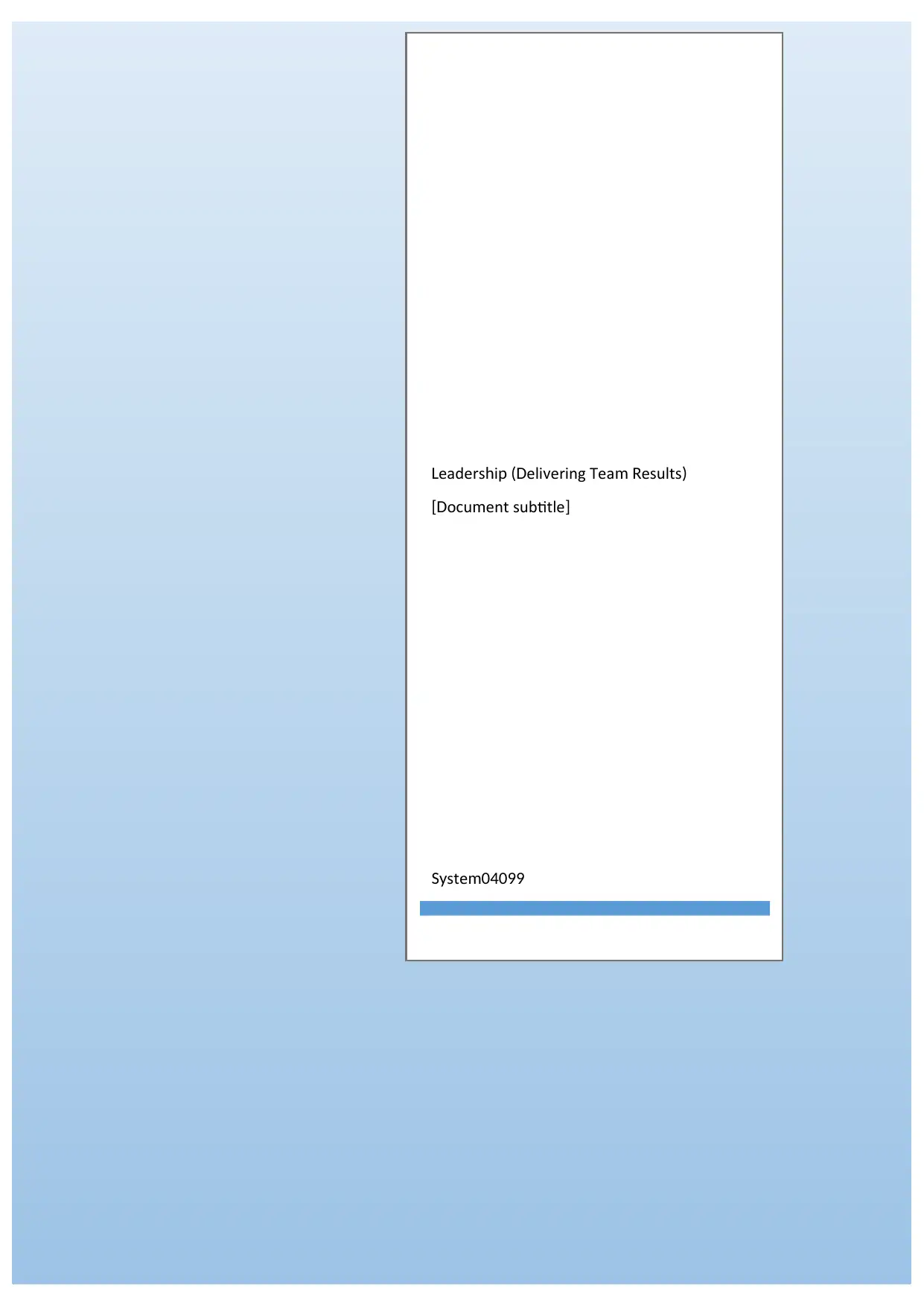
eaders i eli ering Tea esultsL h p (D v m R )
o u ent subtitle[D c m ]
steSy m04099
o u ent subtitle[D c m ]
steSy m04099
Paraphrase This Document
Need a fresh take? Get an instant paraphrase of this document with our AI Paraphraser

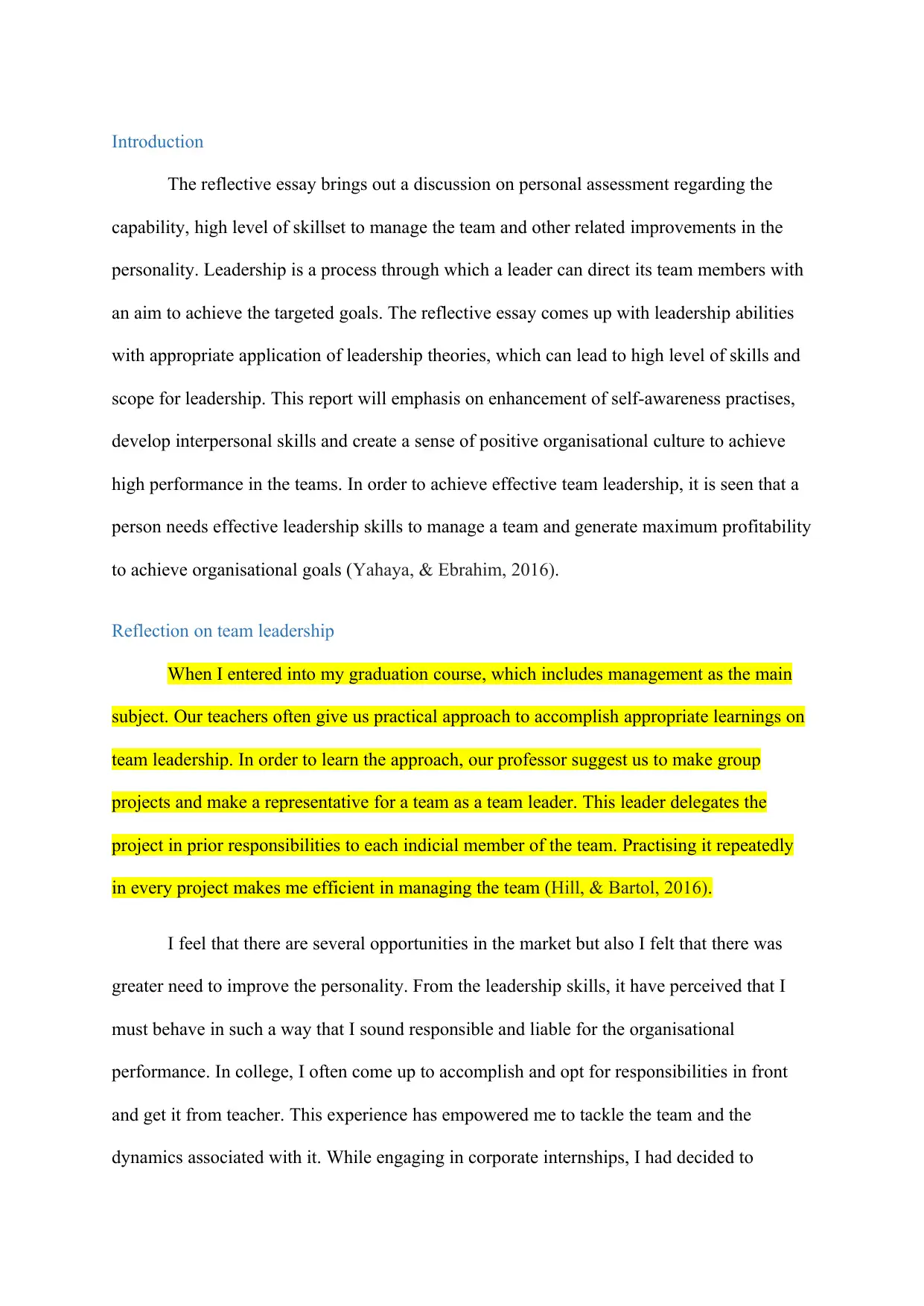
Introduction
The reflective essay brings out a discussion on personal assessment regarding the
capability, high level of skillset to manage the team and other related improvements in the
personality. Leadership is a process through which a leader can direct its team members with
an aim to achieve the targeted goals. The reflective essay comes up with leadership abilities
with appropriate application of leadership theories, which can lead to high level of skills and
scope for leadership. This report will emphasis on enhancement of self-awareness practises,
develop interpersonal skills and create a sense of positive organisational culture to achieve
high performance in the teams. In order to achieve effective team leadership, it is seen that a
person needs effective leadership skills to manage a team and generate maximum profitability
to achieve organisational goals (Yahaya, & Ebrahim, 2016).
Reflection on team leadership
When I entered into my graduation course, which includes management as the main
subject. Our teachers often give us practical approach to accomplish appropriate learnings on
team leadership. In order to learn the approach, our professor suggest us to make group
projects and make a representative for a team as a team leader. This leader delegates the
project in prior responsibilities to each indicial member of the team. Practising it repeatedly
in every project makes me efficient in managing the team (Hill, & Bartol, 2016).
I feel that there are several opportunities in the market but also I felt that there was
greater need to improve the personality. From the leadership skills, it have perceived that I
must behave in such a way that I sound responsible and liable for the organisational
performance. In college, I often come up to accomplish and opt for responsibilities in front
and get it from teacher. This experience has empowered me to tackle the team and the
dynamics associated with it. While engaging in corporate internships, I had decided to
The reflective essay brings out a discussion on personal assessment regarding the
capability, high level of skillset to manage the team and other related improvements in the
personality. Leadership is a process through which a leader can direct its team members with
an aim to achieve the targeted goals. The reflective essay comes up with leadership abilities
with appropriate application of leadership theories, which can lead to high level of skills and
scope for leadership. This report will emphasis on enhancement of self-awareness practises,
develop interpersonal skills and create a sense of positive organisational culture to achieve
high performance in the teams. In order to achieve effective team leadership, it is seen that a
person needs effective leadership skills to manage a team and generate maximum profitability
to achieve organisational goals (Yahaya, & Ebrahim, 2016).
Reflection on team leadership
When I entered into my graduation course, which includes management as the main
subject. Our teachers often give us practical approach to accomplish appropriate learnings on
team leadership. In order to learn the approach, our professor suggest us to make group
projects and make a representative for a team as a team leader. This leader delegates the
project in prior responsibilities to each indicial member of the team. Practising it repeatedly
in every project makes me efficient in managing the team (Hill, & Bartol, 2016).
I feel that there are several opportunities in the market but also I felt that there was
greater need to improve the personality. From the leadership skills, it have perceived that I
must behave in such a way that I sound responsible and liable for the organisational
performance. In college, I often come up to accomplish and opt for responsibilities in front
and get it from teacher. This experience has empowered me to tackle the team and the
dynamics associated with it. While engaging in corporate internships, I had decided to
⊘ This is a preview!⊘
Do you want full access?
Subscribe today to unlock all pages.

Trusted by 1+ million students worldwide

become assistant leader of the leader of operational segment in the department where there
are different cultured people and my leader modify the style of his conversation according to
person because of cultural difference (Fiaz, Su, & Saqib, 2017). A manager must be efficient
enough to motivate the teammates with an aim to accomplish the goals. With the help of
Gallup`s leadership plans, I am making efforts to identify my behaviour by SWOT analysis to
identify strengths, weaknesses, opportunities, and threats so that I can react effectively to
revert through loops of questions. My one of the most important strength is that individual
behaviour aligned with the personal obligations, which influence the performance with team
productivity and team`s morale. On the other hand, as my weakness I was bit impatient,
which often creates negativity amongst the team. I have learnt that team`s success is the
biggest result of individual contribution. Any demotivation among the team members can
lead to damage of morale of entire team. As the responsibility and obligation of the leader
could avail, appropriate information then create a positive cultured workplace that will finally
support the success of the team? When I become a leader and create skillset for team
leadership, I should make sure to gain knowledge and practise it in such a way that
experience become stronger in leading team. From all the related leadership theories, it is
seen that I would prefer to comply with the combination of democratic leadership and
transformational leadership.
A manager can contribute to team, which would be required with greater skills while
managing each employee. The five features to maximise the productivity of the team must
include establishing the clear vision, clear communication, motivating and training
effectively, handling employee performance issues, inspiring trust, lowering the standard
behaviour, and destroying the necessary trust, which will lead to higher performance. Leaders
must act with integrity, and identify influential acts, which do have direct impact on the team.
One had to develop leadership skills and finally lead them to corresponding that will improve
are different cultured people and my leader modify the style of his conversation according to
person because of cultural difference (Fiaz, Su, & Saqib, 2017). A manager must be efficient
enough to motivate the teammates with an aim to accomplish the goals. With the help of
Gallup`s leadership plans, I am making efforts to identify my behaviour by SWOT analysis to
identify strengths, weaknesses, opportunities, and threats so that I can react effectively to
revert through loops of questions. My one of the most important strength is that individual
behaviour aligned with the personal obligations, which influence the performance with team
productivity and team`s morale. On the other hand, as my weakness I was bit impatient,
which often creates negativity amongst the team. I have learnt that team`s success is the
biggest result of individual contribution. Any demotivation among the team members can
lead to damage of morale of entire team. As the responsibility and obligation of the leader
could avail, appropriate information then create a positive cultured workplace that will finally
support the success of the team? When I become a leader and create skillset for team
leadership, I should make sure to gain knowledge and practise it in such a way that
experience become stronger in leading team. From all the related leadership theories, it is
seen that I would prefer to comply with the combination of democratic leadership and
transformational leadership.
A manager can contribute to team, which would be required with greater skills while
managing each employee. The five features to maximise the productivity of the team must
include establishing the clear vision, clear communication, motivating and training
effectively, handling employee performance issues, inspiring trust, lowering the standard
behaviour, and destroying the necessary trust, which will lead to higher performance. Leaders
must act with integrity, and identify influential acts, which do have direct impact on the team.
One had to develop leadership skills and finally lead them to corresponding that will improve
Paraphrase This Document
Need a fresh take? Get an instant paraphrase of this document with our AI Paraphraser
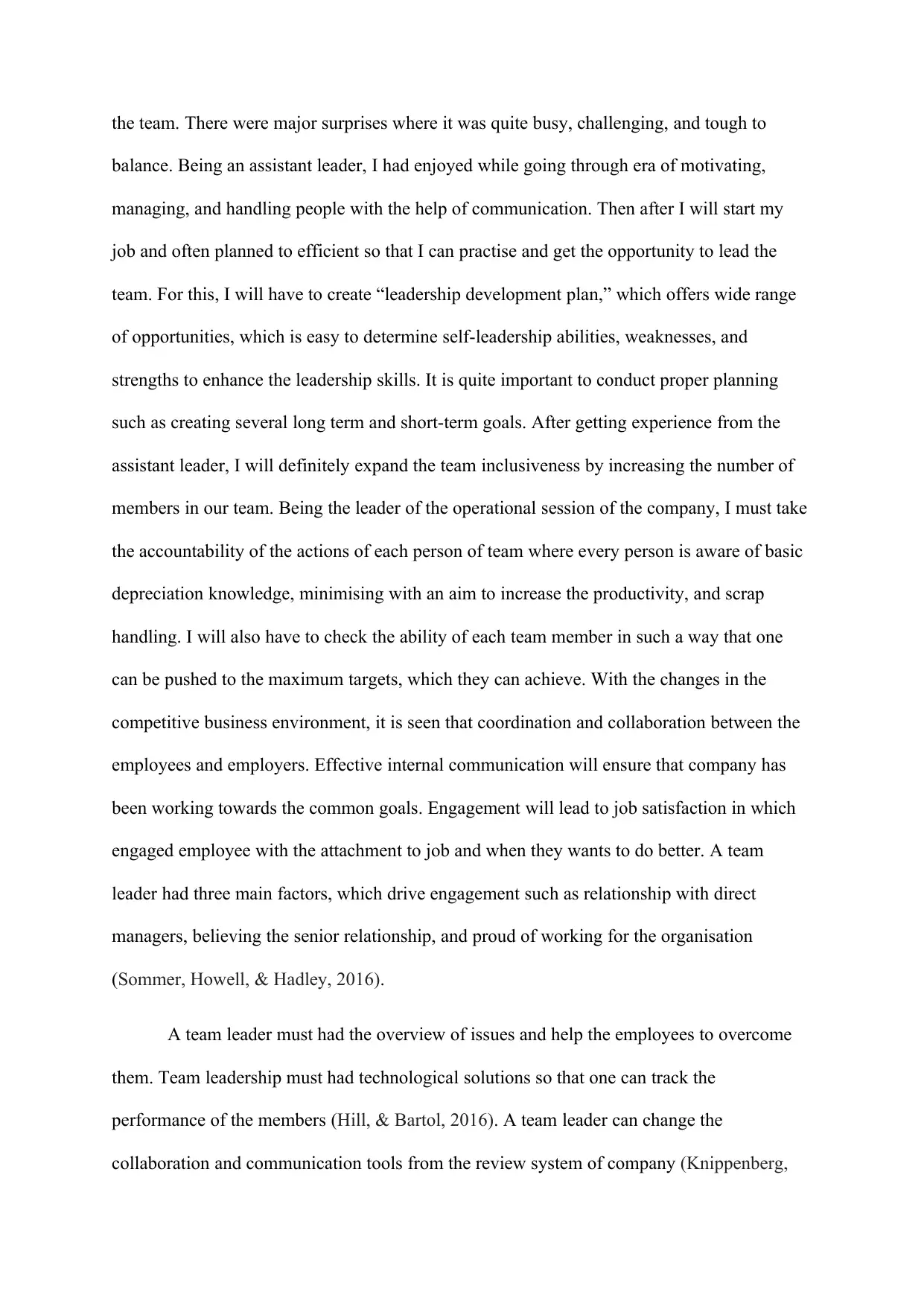
the team. There were major surprises where it was quite busy, challenging, and tough to
balance. Being an assistant leader, I had enjoyed while going through era of motivating,
managing, and handling people with the help of communication. Then after I will start my
job and often planned to efficient so that I can practise and get the opportunity to lead the
team. For this, I will have to create “leadership development plan,” which offers wide range
of opportunities, which is easy to determine self-leadership abilities, weaknesses, and
strengths to enhance the leadership skills. It is quite important to conduct proper planning
such as creating several long term and short-term goals. After getting experience from the
assistant leader, I will definitely expand the team inclusiveness by increasing the number of
members in our team. Being the leader of the operational session of the company, I must take
the accountability of the actions of each person of team where every person is aware of basic
depreciation knowledge, minimising with an aim to increase the productivity, and scrap
handling. I will also have to check the ability of each team member in such a way that one
can be pushed to the maximum targets, which they can achieve. With the changes in the
competitive business environment, it is seen that coordination and collaboration between the
employees and employers. Effective internal communication will ensure that company has
been working towards the common goals. Engagement will lead to job satisfaction in which
engaged employee with the attachment to job and when they wants to do better. A team
leader had three main factors, which drive engagement such as relationship with direct
managers, believing the senior relationship, and proud of working for the organisation
(Sommer, Howell, & Hadley, 2016).
A team leader must had the overview of issues and help the employees to overcome
them. Team leadership must had technological solutions so that one can track the
performance of the members (Hill, & Bartol, 2016). A team leader can change the
collaboration and communication tools from the review system of company (Knippenberg,
balance. Being an assistant leader, I had enjoyed while going through era of motivating,
managing, and handling people with the help of communication. Then after I will start my
job and often planned to efficient so that I can practise and get the opportunity to lead the
team. For this, I will have to create “leadership development plan,” which offers wide range
of opportunities, which is easy to determine self-leadership abilities, weaknesses, and
strengths to enhance the leadership skills. It is quite important to conduct proper planning
such as creating several long term and short-term goals. After getting experience from the
assistant leader, I will definitely expand the team inclusiveness by increasing the number of
members in our team. Being the leader of the operational session of the company, I must take
the accountability of the actions of each person of team where every person is aware of basic
depreciation knowledge, minimising with an aim to increase the productivity, and scrap
handling. I will also have to check the ability of each team member in such a way that one
can be pushed to the maximum targets, which they can achieve. With the changes in the
competitive business environment, it is seen that coordination and collaboration between the
employees and employers. Effective internal communication will ensure that company has
been working towards the common goals. Engagement will lead to job satisfaction in which
engaged employee with the attachment to job and when they wants to do better. A team
leader had three main factors, which drive engagement such as relationship with direct
managers, believing the senior relationship, and proud of working for the organisation
(Sommer, Howell, & Hadley, 2016).
A team leader must had the overview of issues and help the employees to overcome
them. Team leadership must had technological solutions so that one can track the
performance of the members (Hill, & Bartol, 2016). A team leader can change the
collaboration and communication tools from the review system of company (Knippenberg,
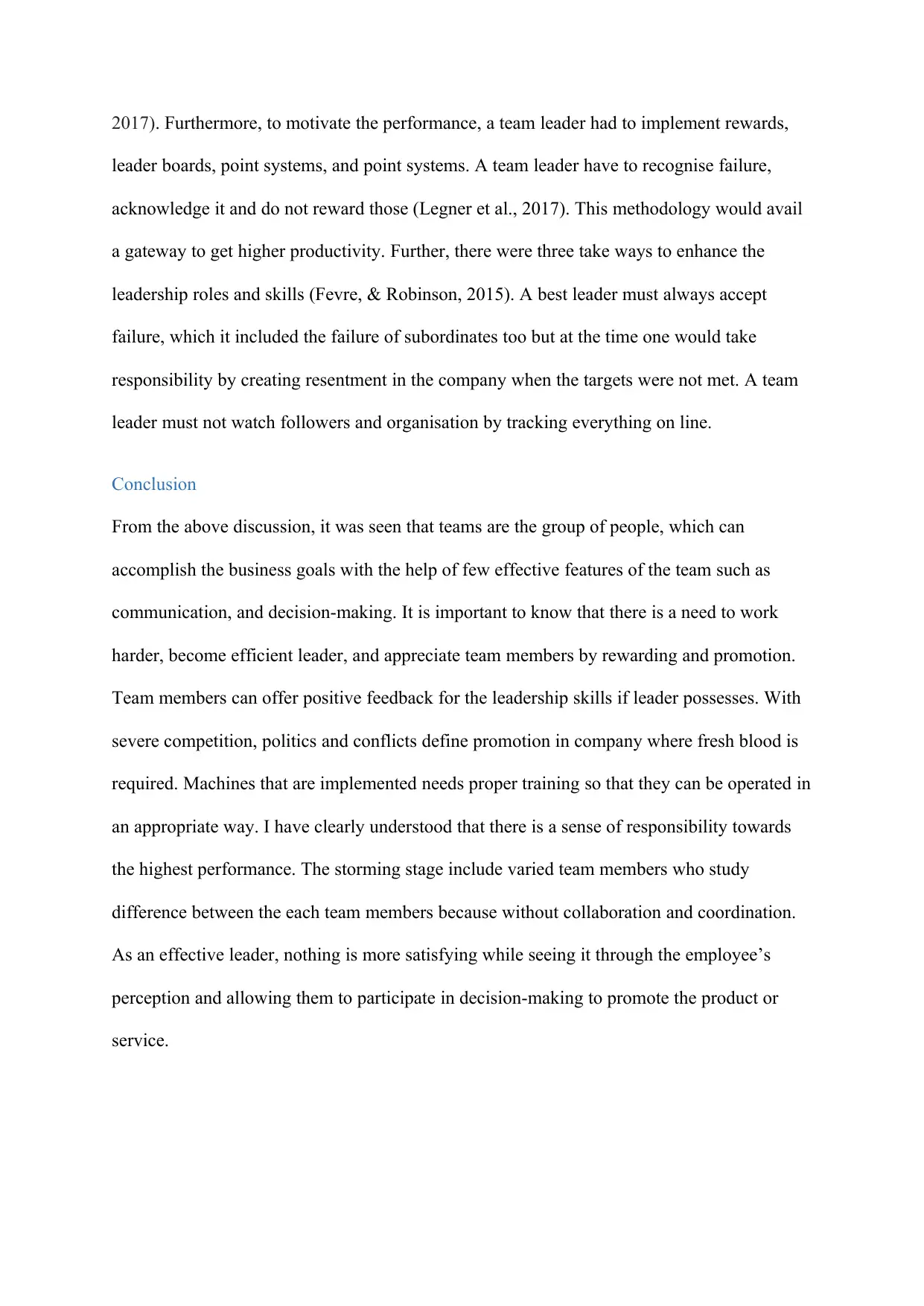
2017). Furthermore, to motivate the performance, a team leader had to implement rewards,
leader boards, point systems, and point systems. A team leader have to recognise failure,
acknowledge it and do not reward those (Legner et al., 2017). This methodology would avail
a gateway to get higher productivity. Further, there were three take ways to enhance the
leadership roles and skills (Fevre, & Robinson, 2015). A best leader must always accept
failure, which it included the failure of subordinates too but at the time one would take
responsibility by creating resentment in the company when the targets were not met. A team
leader must not watch followers and organisation by tracking everything on line.
Conclusion
From the above discussion, it was seen that teams are the group of people, which can
accomplish the business goals with the help of few effective features of the team such as
communication, and decision-making. It is important to know that there is a need to work
harder, become efficient leader, and appreciate team members by rewarding and promotion.
Team members can offer positive feedback for the leadership skills if leader possesses. With
severe competition, politics and conflicts define promotion in company where fresh blood is
required. Machines that are implemented needs proper training so that they can be operated in
an appropriate way. I have clearly understood that there is a sense of responsibility towards
the highest performance. The storming stage include varied team members who study
difference between the each team members because without collaboration and coordination.
As an effective leader, nothing is more satisfying while seeing it through the employee’s
perception and allowing them to participate in decision-making to promote the product or
service.
leader boards, point systems, and point systems. A team leader have to recognise failure,
acknowledge it and do not reward those (Legner et al., 2017). This methodology would avail
a gateway to get higher productivity. Further, there were three take ways to enhance the
leadership roles and skills (Fevre, & Robinson, 2015). A best leader must always accept
failure, which it included the failure of subordinates too but at the time one would take
responsibility by creating resentment in the company when the targets were not met. A team
leader must not watch followers and organisation by tracking everything on line.
Conclusion
From the above discussion, it was seen that teams are the group of people, which can
accomplish the business goals with the help of few effective features of the team such as
communication, and decision-making. It is important to know that there is a need to work
harder, become efficient leader, and appreciate team members by rewarding and promotion.
Team members can offer positive feedback for the leadership skills if leader possesses. With
severe competition, politics and conflicts define promotion in company where fresh blood is
required. Machines that are implemented needs proper training so that they can be operated in
an appropriate way. I have clearly understood that there is a sense of responsibility towards
the highest performance. The storming stage include varied team members who study
difference between the each team members because without collaboration and coordination.
As an effective leader, nothing is more satisfying while seeing it through the employee’s
perception and allowing them to participate in decision-making to promote the product or
service.
⊘ This is a preview!⊘
Do you want full access?
Subscribe today to unlock all pages.

Trusted by 1+ million students worldwide
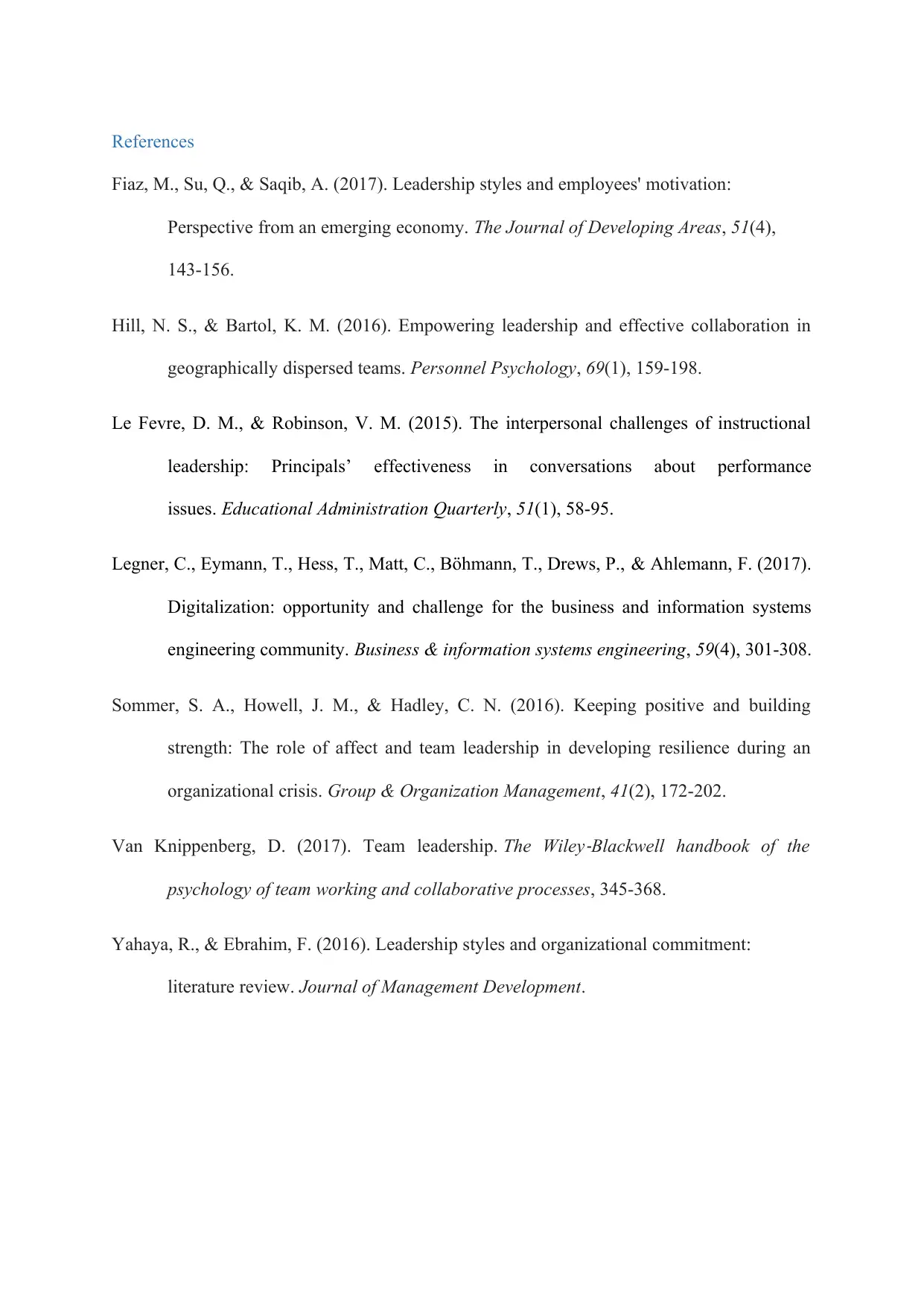
References
Fiaz, M., Su, Q., & Saqib, A. (2017). Leadership styles and employees' motivation:
Perspective from an emerging economy. The Journal of Developing Areas, 51(4),
143-156.
Hill, N. S., & Bartol, K. M. (2016). Empowering leadership and effective collaboration in
geographically dispersed teams. Personnel Psychology, 69(1), 159-198.
Le Fevre, D. M., & Robinson, V. M. (2015). The interpersonal challenges of instructional
leadership: Principals’ effectiveness in conversations about performance
issues. Educational Administration Quarterly, 51(1), 58-95.
Legner, C., Eymann, T., Hess, T., Matt, C., Böhmann, T., Drews, P., & Ahlemann, F. (2017).
Digitalization: opportunity and challenge for the business and information systems
engineering community. Business & information systems engineering, 59(4), 301-308.
Sommer, S. A., Howell, J. M., & Hadley, C. N. (2016). Keeping positive and building
strength: The role of affect and team leadership in developing resilience during an
organizational crisis. Group & Organization Management, 41(2), 172-202.
Van Knippenberg, D. (2017). Team leadership. The Wiley
‐Blackwell handbook of the
psychology of team working and collaborative processes, 345-368.
Yahaya, R., & Ebrahim, F. (2016). Leadership styles and organizational commitment:
literature review. Journal of Management Development.
Fiaz, M., Su, Q., & Saqib, A. (2017). Leadership styles and employees' motivation:
Perspective from an emerging economy. The Journal of Developing Areas, 51(4),
143-156.
Hill, N. S., & Bartol, K. M. (2016). Empowering leadership and effective collaboration in
geographically dispersed teams. Personnel Psychology, 69(1), 159-198.
Le Fevre, D. M., & Robinson, V. M. (2015). The interpersonal challenges of instructional
leadership: Principals’ effectiveness in conversations about performance
issues. Educational Administration Quarterly, 51(1), 58-95.
Legner, C., Eymann, T., Hess, T., Matt, C., Böhmann, T., Drews, P., & Ahlemann, F. (2017).
Digitalization: opportunity and challenge for the business and information systems
engineering community. Business & information systems engineering, 59(4), 301-308.
Sommer, S. A., Howell, J. M., & Hadley, C. N. (2016). Keeping positive and building
strength: The role of affect and team leadership in developing resilience during an
organizational crisis. Group & Organization Management, 41(2), 172-202.
Van Knippenberg, D. (2017). Team leadership. The Wiley
‐Blackwell handbook of the
psychology of team working and collaborative processes, 345-368.
Yahaya, R., & Ebrahim, F. (2016). Leadership styles and organizational commitment:
literature review. Journal of Management Development.
1 out of 7
Related Documents
Your All-in-One AI-Powered Toolkit for Academic Success.
+13062052269
info@desklib.com
Available 24*7 on WhatsApp / Email
![[object Object]](/_next/static/media/star-bottom.7253800d.svg)
Unlock your academic potential
Copyright © 2020–2025 A2Z Services. All Rights Reserved. Developed and managed by ZUCOL.





